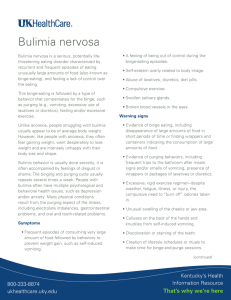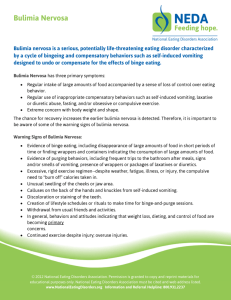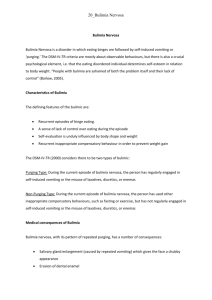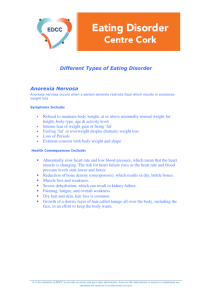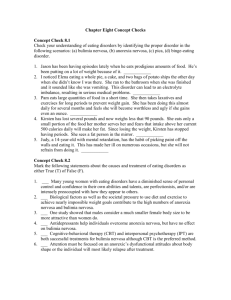Bulimia Nervosa - Creighton University
advertisement
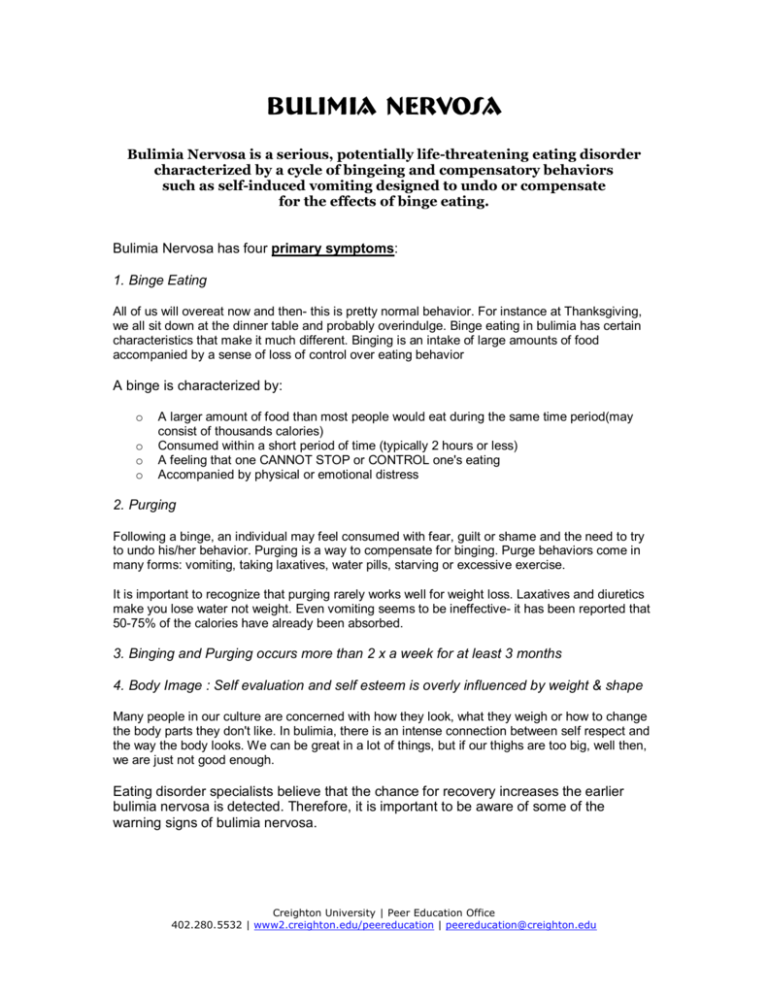
Bulimia Nervosa Bulimia Nervosa is a serious, potentially life-threatening eating disorder characterized by a cycle of bingeing and compensatory behaviors such as self-induced vomiting designed to undo or compensate for the effects of binge eating. Bulimia Nervosa has four primary symptoms: 1. Binge Eating All of us will overeat now and then- this is pretty normal behavior. For instance at Thanksgiving, we all sit down at the dinner table and probably overindulge. Binge eating in bulimia has certain characteristics that make it much different. Binging is an intake of large amounts of food accompanied by a sense of loss of control over eating behavior A binge is characterized by: o o o o A larger amount of food than most people would eat during the same time period(may consist of thousands calories) Consumed within a short period of time (typically 2 hours or less) A feeling that one CANNOT STOP or CONTROL one's eating Accompanied by physical or emotional distress 2. Purging Following a binge, an individual may feel consumed with fear, guilt or shame and the need to try to undo his/her behavior. Purging is a way to compensate for binging. Purge behaviors come in many forms: vomiting, taking laxatives, water pills, starving or excessive exercise. It is important to recognize that purging rarely works well for weight loss. Laxatives and diuretics make you lose water not weight. Even vomiting seems to be ineffective- it has been reported that 50-75% of the calories have already been absorbed. 3. Binging and Purging occurs more than 2 x a week for at least 3 months 4. Body Image : Self evaluation and self esteem is overly influenced by weight & shape Many people in our culture are concerned with how they look, what they weigh or how to change the body parts they don't like. In bulimia, there is an intense connection between self respect and the way the body looks. We can be great in a lot of things, but if our thighs are too big, well then, we are just not good enough. Eating disorder specialists believe that the chance for recovery increases the earlier bulimia nervosa is detected. Therefore, it is important to be aware of some of the warning signs of bulimia nervosa. Creighton University | Peer Education Office 402.280.5532 | www2.creighton.edu/peereducation | peereducation@creighton.edu Warning Signs of Bulimia Nervosa: • Evidence of binge-eating, including disappearance of large amounts of food in short periods of time or the existence of wrappers and containers indicating the consumption of large amounts of food. • Evidence of purging behaviors, including frequent trips to the bathroom after meals, signs and/or smells of vomiting, presence of wrappers or packages of laxatives or diuretics. • Excessive, rigid exercise regimen--despite weather, fatigue, illness, or injury--the need to “burn off” calories taken in. • Unusual swelling of the cheeks or jaw area. • Calluses on the back of the hands and knuckles from self-induced vomiting. • Discoloration or staining of the teeth. • Creation of complex lifestyle schedules or rituals to make time for binge-andpurge sessions. • Withdrawal from usual friends and activities. • In general, behaviors and attitudes indicating that weight loss, dieting, and control of food are becoming primary concerns. Bulimia nervosa can be extremely harmful to the body. The recurrent binge-and-purge cycles can impact the entire digestive system and purge behaviors can lead to electrolyte and chemical imbalances in the body that affect the heart and other major organ functions. Health Consequences of Bulimia Nervosa: • Electrolyte imbalances that can lead to irregular heartbeats and possibly heart failure and death. Electrolyte imbalance is caused by dehydration and loss of potassium and sodium from the body as a result of purging behaviors. • Inflammation and possible rupture of the esophagus from frequent vomiting. • Tooth decay and staining from stomach acids released during frequent vomiting. • Chronic irregular bowel movements and constipation as a result of laxative abuse. • Gastric rupture is an uncommon but possible side effect of binge eating. Statistics about Bulimia Nervosa: • Bulimia nervosa affects 1-2% of adolescent and young adult women. • Approximately 80% of bulimia nervosa patients are female (Gidwani, 1997). • People struggling with bulimia nervosa will often appear to be of average body weight. • Many people struggling with bulimia nervosa recognize that their behaviors are unusual and perhaps dangerous to their health. • Bulimia nervosa is frequently associated with symptoms of depression and changes in social adjustment. Source: Anorexia Nervosa and Associated Disorders www.anad.org Creighton University | Peer Education Office 402.280.5532 | www2.creighton.edu/peereducation | peereducation@creighton.edu
